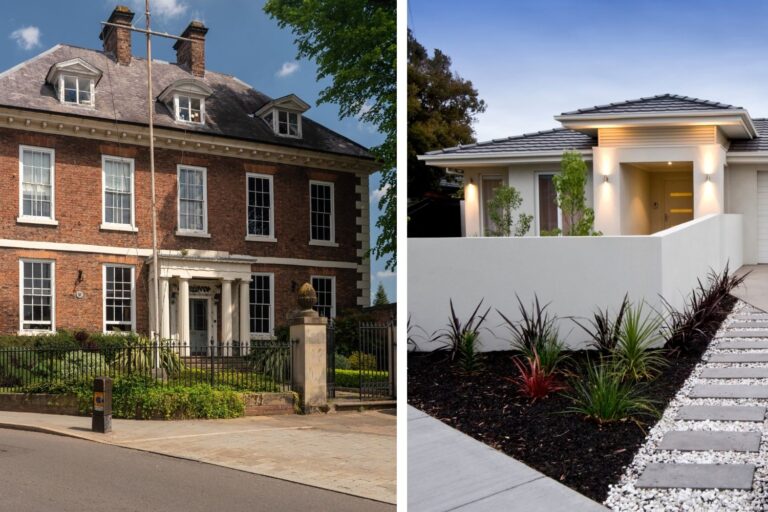The UK and Australia share many cultural similarities despite being on opposite sides of the globe. Both nations speak English, have Westminster-style parliaments, share a passion for cricket and rugby, and enjoy pub culture. However, when it comes to residential architecture and home design, these two Commonwealth nations couldn’t be more different.
From compact Victorian terraces in London to sprawling single-story ranch homes in Sydney, the contrast between British and Australian housing reflects each country’s unique climate, geography, and cultural priorities. Whether you’re considering relocating, curious about international housing trends, or simply interested in architectural differences, this comprehensive comparison reveals fascinating insights into how geography shapes the way we live.
Home Size and Layout: Compact vs. Spacious
The most striking difference between British and Australian homes is their size. The average UK home is about 818 sq ft, making British homes among the smallest in the developed world. This modest footprint is largely due to urban density, with one in five British residents living in flats (apartments). Most British houses are terraced (row houses) or semi-detached, with truly detached homes being rare outside of expensive country estates.
Australian homes tell a completely different story. Australia boasts the largest average home size globally at 2,303 square feet—nearly three times larger than the average British home. Detached single-family homes dominate the Australian housing market, with 70% of properties being standalone houses. Only 10% of Australians live in apartments, reflecting the country’s abundant land and lower population density.
Layout differences are equally significant. British homes typically feature multiple stories with bedrooms located upstairs. This vertical design maximizes limited land while providing natural privacy. Individual rooms are generally separated by doors and walls, creating distinct spaces that help retain heat during Britain’s cold, damp winters.
In Australia, you are much more likely to go with a single storey home. These homes are generally open plan, although bedrooms and bathrooms are still closed off for privacy. This open plan layout helps with ventilation and socialization, while being on a single story makes these homes easier to navigate when getting older. For more ideas on optimizing your home’s layout, explore our guest room makeover tips.
Building Materials: Brick Fortresses vs. Breathable Structures
British homes have been predominantly built from brick since the Victorian era (1837-1901). This isn’t merely aesthetic—brick construction provides excellent insulation and moisture resistance, essential for the UK’s damp, temperate climate. Britain has one of the world’s oldest housing stocks, with 38% of properties built before 1946, testament to brick’s durability and longevity.
Australian home builders favor lighter, more breathable materials suited to the country’s warmer climate. Weatherboard (horizontal wooden planks) and rendered brick veneer are popular choices, offering superior ventilation and mold resistance—particularly important in humid regions like Queensland. In bushfire-prone areas, fire-resistant fiber cement cladding has become standard.
Roofing choices reflect each nation’s weather priorities. British homes typically use asphalt shingles designed to withstand wind and heavy rain. Australian homes favor metal roofs that reflect heat and resist fire. Interestingly, clay tiles remain popular in both countries as a durable, weather-resistant option.
Flooring differs significantly too. British homes commonly feature laminate or carpet (the latter providing valuable insulation), while Australian homes showcase native hardwoods like jarrah and spotted gum, which stay cool underfoot and handle temperature fluctuations well.
Heating and Cooling Systems: Climate-Driven Necessities
Climate differences drive dramatically different heating and cooling priorities in each country.
British homes are designed primarily for heat retention. Traditional gas boiler systems with radiators in every room remain the standard, providing rapid, effective heating during sub-zero winter temperatures. While expensive to operate, these systems are necessary when temperatures regularly drop below freezing. Air conditioning is rare—only about 5% of British homes have AC units. During increasingly warm summers, portable fans remain the most common cooling solution, though a growing number of UK residents are starting to look into AC units.
Air conditioning is virtually universal in Australian homes, and for good reason. Summer temperatures frequently exceed 40°C (104°F) in many regions, making effective cooling essential for safety and comfort. The type of AC varies by region: evaporative coolers dominate in Western Australia’s dry climate due to their energy efficiency, while reverse-cycle (heat pump) systems are popular in southern states where both heating and cooling are needed. Portable heaters provide supplemental warmth during cooler months in most areas.
Maintaining comfortable indoor temperatures year-round becomes easier with proper home care. Learn more about keeping your home fresh with natural methods.
Outdoor Spaces: Gardens vs. Backyards
British residents typically refer to their outdoor space as a “garden,” regardless of whether actual gardening occurs. The UK’s temperate climate supports diverse plant life, making ornamental gardening a beloved national pastime. Manicured lawns, colorful flower beds, and vegetable patches are standard features. Greenhouses enable year-round cultivation of tender plants. Patios and decks provide outdoor seating during brief summer months, while conservatories—glass-enclosed rooms—offer a hybrid indoor-outdoor space that can be enjoyed even during rainy weather.
Australians call their outdoor area a “backyard,” emphasizing its function as an extension of living space. These areas are designed for entertaining and relaxation, with the barbecue serving as the centerpiece. Australian backyards see year-round use, though residents retreat indoors or under covered verandas during extreme heat. As for plants found in Australian backyards, you’re more likely to find native plants that can deal with Australia’s unique climate. Lawns are very popular, but water shortages and environmental concerns are resulting in growing backlash.
Transform your indoor and outdoor living spaces with ideas from our home decorating guides.
Additional Architectural Differences
Window Styles and Glazing: British homes typically feature double or triple-glazed windows to minimize heat loss. Sash windows are common in older properties, while modern homes use tilt-and-turn or casement windows. Australian homes favor larger windows to maximize natural light and cross-ventilation, often with external shutters or awnings to control heat and glare.
Insulation Standards: UK building regulations mandate high insulation levels to retain heat. Wall, roof, and floor insulation is standard in new builds. Australian homes focus on insulation that keeps heat out rather than in, with special attention to roof insulation where most heat enters. Ventilation is equally important to prevent moisture buildup.
Storage Solutions: British homes maximize vertical space with loft conversions, under-stair storage, and built-in wardrobes due to limited square footage. Australian homes offer more generous storage with walk-in closets, large garages (often double or triple), and dedicated storage rooms being commonplace. Optimize your space with our furniture measurement guide.
Cultural Influences on Home Design
Beyond climate and geography, cultural values shape housing preferences in each nation.
British home design reflects centuries of urban development and a cultural appreciation for history and tradition. Listed buildings and conservation areas preserve architectural heritage, often limiting renovation options. Proximity to public transportation, schools, and shops takes priority over property size, reflecting Britain’s compact urban planning.
Australian home design emphasizes indoor-outdoor living, privacy, and space. The “Great Australian Dream” of owning a detached home with a sizable yard remains culturally significant. Homes are designed for entertaining, with open-plan spaces that accommodate large gatherings. Car dependency is built into Australian suburban design, with multiple-car garages standard and cul-de-sac layouts common.
Energy Efficiency and Sustainability Trends
Both nations are increasingly prioritizing energy efficiency and sustainable design, though approaches differ.
The UK has implemented stringent energy efficiency standards, with Energy Performance Certificates (EPCs) required for all property sales and rentals. Solar panels, heat pumps, and smart thermostats are becoming more common as the country works toward net-zero emissions targets. Retrofitting older homes remains a significant challenge.
Australia leads in residential solar panel adoption, with over 30% of homes having solar installations—the highest rate globally. Water conservation features like rainwater tanks and greywater systems are increasingly common, particularly in drought-prone regions. However, Australia’s home energy ratings are generally lower than Europe’s, with ongoing debates about improving building standards.
Support sustainable living with eco-friendly cleaning methods and our natural cleaning recipes.
Property Ownership and Housing Markets
The path to homeownership differs significantly between the two countries. UK property prices, particularly in London and the Southeast, have soared to levels where average homes cost over 10 times the average salary. First-time buyers often rely on Help to Buy schemes or family assistance. Leasehold properties (where buyers own the property but not the land) are common for flats, adding complexity to ownership.
Australian property markets, particularly in Sydney and Melbourne, also face affordability challenges, though homeownership rates remain higher than in the UK. Freehold ownership (owning both property and land) is standard. Government incentives like First Home Owner Grants help young buyers enter the market. Australia’s larger home sizes mean buyers get more space for their money compared to the UK, even if absolute prices are high.
Regional Variations Within Each Country
It’s important to note that both countries show significant regional variation in housing styles.
In the UK, Scottish homes often feature stone construction and are built to withstand harsher weather than southern English homes. Welsh properties frequently incorporate local slate, while Northern Ireland has its own distinct architectural traditions. London and Southeast England have the smallest, most expensive homes, while northern regions offer larger properties at lower prices.
Australian housing varies dramatically by climate zone. Queensland’s tropical north favors raised homes on stilts with wide verandas for ventilation and flood protection. Tasmania’s cooler climate results in homes more similar to British designs with better heating systems. Western Australia’s mining boom created a unique architectural style emphasizing outdoor living. Victoria and South Australia blend features suitable for variable climates.
Key Takeaways: British vs Australian Homes
British and Australian homes represent two distinct approaches to residential architecture, each perfectly adapted to its environment and cultural context:
British Homes: Compact two-story brick structures averaging 818 sq ft, designed for heat retention with radiator heating, minimal AC, separate rooms, planted gardens, and close proximity to urban amenities. Built to last centuries with traditional materials and methods.
Australian Homes: Spacious single-story detached houses averaging 2,303 sq ft, designed for cooling with universal AC, open-plan layouts, entertaining-focused backyards, and suburban sprawl. Built with lighter, breathable materials suited to hot, dry conditions.
These differences illustrate how climate, geography, and culture fundamentally shape our living spaces. British homes maximize limited land through vertical design and prioritize warmth and coziness. Australian homes spread horizontally across abundant land, emphasizing space, light, and indoor-outdoor living.
Understanding these differences provides valuable insights for anyone considering relocation, studying international architecture, or simply appreciating how people adapt to their environments. Whether you prefer the charm of a cozy British cottage or the spaciousness of an Australian family home, each style offers unique advantages shaped by centuries of adaptation to local conditions.
Related Home Living Resources
Enhance your living space with these helpful guides:
- Spring cleaning tips for a fresh home
- Natural spring cleaning DIY solutions
- Master bedroom makeover inspiration
- Creating the perfect guest room retreat
- Ways to spruce up your home with fabric
- Modern furniture options for your home
- Quality furniture for every room
- Summer linens to keep your home cool
Better Living uses affiliate links. If you make a purchase through them, we may receive a small commission (for which we are deeply grateful) at no cost to you.



